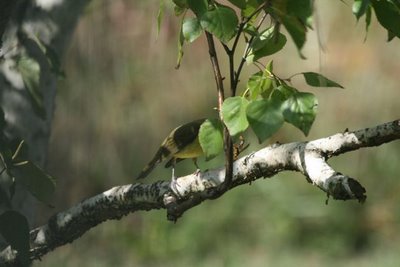
Could it be? Is it a paper wasp? Eeek!
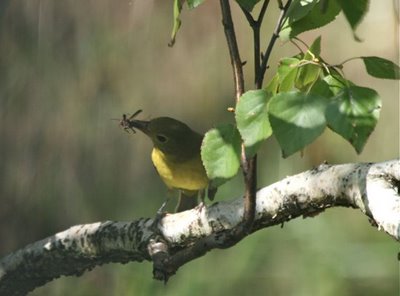
Durn tootin'. It's a wasp. Yikes. Notice how he's holding it? By the bidness end. And he's biting it for all he's worth.
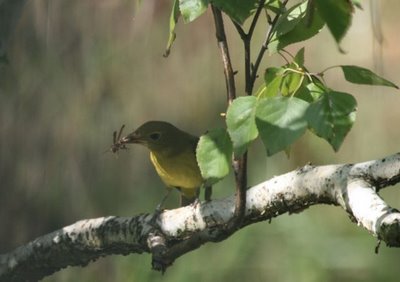
The crushing power of a tanager bill is considerable. I'm sure he disabled the stinger the moment he grabbed it. That's one of the benefits of having hard lips. Sometimes I think how cool it would be to have a beak. You could open bottles and cans, pre-drill holes, remove tags, henpeck your husband when he needed it.
Even more mastication of the abdomen.
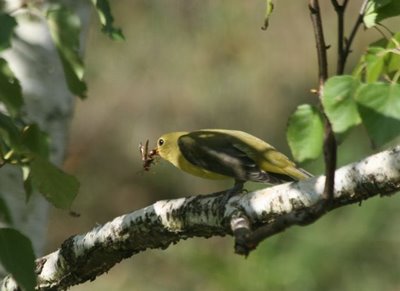
Only when the abdomen was thoroughly crushed did the bird move on to processing the thorax and head.
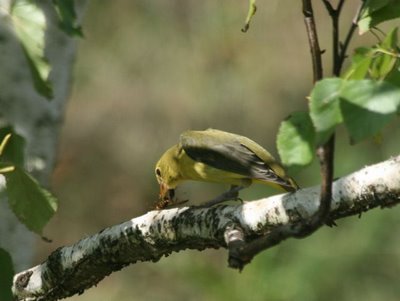
This is the last shot before he swallowed his catch. Look how he's got the wasp's abdomen all mooshed out.
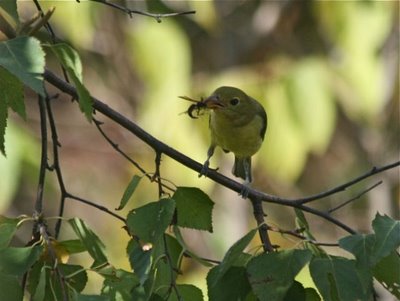
Tanagers as a genus are well-adapted to feeding on bees and wasps. In fact, most Augusts see a young male summer tanager or two, perched on one of our high backyard snags, leaping up and catching yellowjackets and wasps as they sail by. They'll repair back to the snag to bite and hammer the bug into stingless submission before swallowing it down. I have a friend in Connecticut who had a summer tanager spend most of the winter in his Old Lyme backyard, nailing honeybees as they emerged from the hive for a look around. Those bees kept the tanager going through quite a bit of cold and snow. Hank was glad to donate to the redbird's cause.
And that is what I know about tanagers and Hymenopterae.






15 comments:
Julie, thanks so much for this educational and most amusing post. Henpeck the husband. I nearly fell out my chair laughing.
love the play by play...beautiful
Amazing, isn't it? He doesn't know that the lobelia is not food. Yet he knows exactly the way to deftly and expertly eat the wasp. Nice series.
Yes, I got my life (and state) Summer Tanager at Hank's hive that winter.
Wow--at first, I feared a stung bird. But not to worry.
Thanks (for the millionth time?) for another science lesson. Eee eee to the Science Chimp.
Yeah, henpeck the husband...GULP AND GIGGLE!
After your last post, I thought I might have seen a Tanager here - but no, today it's a female Ruby-Crowned Kinglet. Tiny and very flitty. Love it!
How to eat a wasp by a Tanager is excellent. I learn so much here.
I got my life summer tanager this fall with the motmot! Thanks for this great post! I should do a human post on how to eat an apple pie in Siberia when you discover there is a wedge of salmon in the middle. It took every bit of skill I had not to haму an unpleasant evacuation of it out of my mouth and throat.
pardon the Russian keyboard
SALMON?!? I'll take sharp chedda, thanks. Thanks for making me splurt my tea.
Only you, Tim, writing from...Siberia?? Gotta go to "From the Faraway, Nearby" and catch up, obviously.
Wow, that is some series of photos Julie! How neat to see him do what Tanagers "do" to eat wasps!
Wonderful action commentary there, Julie. I always learn so much from the Science Chimp! Gotta agree with the MountainWoman tho' -- it's wild how he knows instinctively how to handle that stinger, yet seems to have no clue on what else in the area is edible (or not so much).
Wait. You mean you DON'T have a hard beak? Then how'd I git all them dents in my haid?
Hi Kyle,
Well, in the tanager's defense, I don't think he "has no clue" about what else besides insects might be edible. I'd look at it this way: He's experimenting with foods he has not yet encountered. He's expanding his data bank about what is and what isn't edible. Perhaps he was fed wasps by his parents; he knows they're edible, and perhaps instinctively knows to disable them before eating them. Perhaps he saw another bird processing a wasp and is copying what he observed. But he's never seen cardinalflower, and he's just checking to see if it's any good.
That's why I so enjoy young birds, watching them navigate through their environments.
The dents were already there, dear. Pity the science of phrenology has faded to the extent that we'll never know their significance.
I like these sequences, Julie. It really brings still images to life.
And shows so much of his character by his tipped head.
He must have been neat to have so close.
Post a Comment